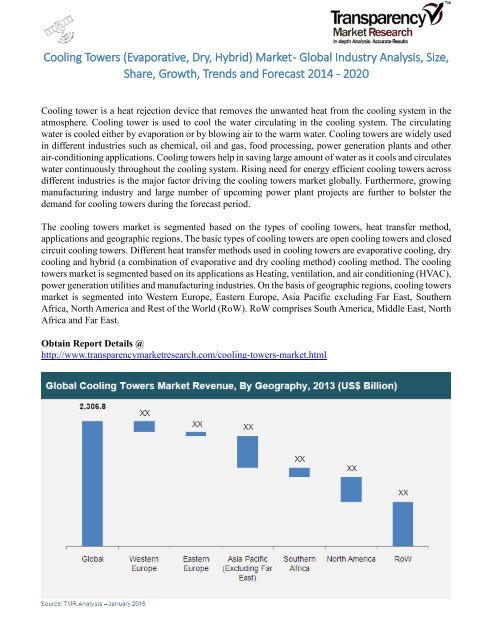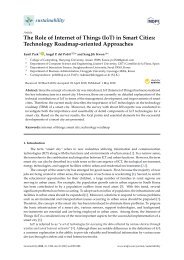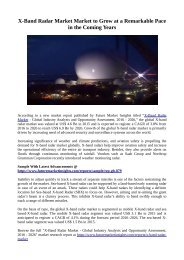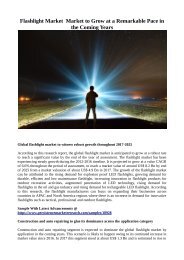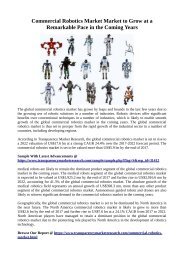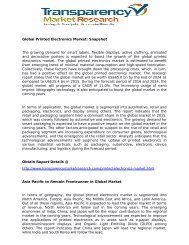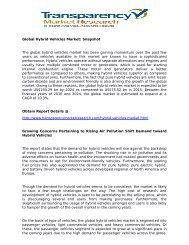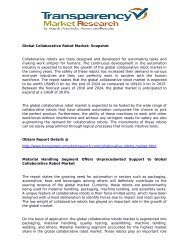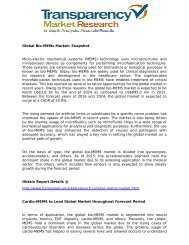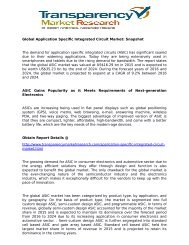Cooling Towers (Evaporative, Dry, Hybrid) Market - Global Industry Analysis, Size, Share, Growth, Trends and Forecast 2014 - 2020
You also want an ePaper? Increase the reach of your titles
YUMPU automatically turns print PDFs into web optimized ePapers that Google loves.
<strong>Cooling</strong> <strong>Towers</strong> (<strong>Evaporative</strong>, <strong>Dry</strong>, <strong>Hybrid</strong>) <strong>Market</strong> - <strong>Global</strong> <strong>Industry</strong> <strong>Analysis</strong>, <strong>Size</strong>,<br />
<strong>Share</strong>, <strong>Growth</strong>, <strong>Trends</strong> <strong>and</strong> <strong>Forecast</strong> <strong>2014</strong> - <strong>2020</strong><br />
<strong>Cooling</strong> tower is a heat rejection device that removes the unwanted heat from the cooling system in the<br />
atmosphere. <strong>Cooling</strong> tower is used to cool the water circulating in the cooling system. The circulating<br />
water is cooled either by evaporation or by blowing air to the warm water. <strong>Cooling</strong> towers are widely used<br />
in different industries such as chemical, oil <strong>and</strong> gas, food processing, power generation plants <strong>and</strong> other<br />
air-conditioning applications. <strong>Cooling</strong> towers help in saving large amount of water as it cools <strong>and</strong> circulates<br />
water continuously throughout the cooling system. Rising need for energy efficient cooling towers across<br />
different industries is the major factor driving the cooling towers market globally. Furthermore, growing<br />
manufacturing industry <strong>and</strong> large number of upcoming power plant projects are further to bolster the<br />
dem<strong>and</strong> for cooling towers during the forecast period.<br />
The cooling towers market is segmented based on the types of cooling towers, heat transfer method,<br />
applications <strong>and</strong> geographic regions. The basic types of cooling towers are open cooling towers <strong>and</strong> closed<br />
circuit cooling towers. Different heat transfer methods used in cooling towers are evaporative cooling, dry<br />
cooling <strong>and</strong> hybrid (a combination of evaporative <strong>and</strong> dry cooling method) cooling method. The cooling<br />
towers market is segmented based on its applications as Heating, ventilation, <strong>and</strong> air conditioning (HVAC),<br />
power generation utilities <strong>and</strong> manufacturing industries. On the basis of geographic regions, cooling towers<br />
market is segmented into Western Europe, Eastern Europe, Asia Pacific excluding Far East, Southern<br />
Africa, North America <strong>and</strong> Rest of the World (RoW). RoW comprises South America, Middle East, North<br />
Africa <strong>and</strong> Far East.<br />
Obtain Report Details @<br />
http://www.transparencymarketresearch.com/cooling-towers-market.html
The most common cooling towers worldwide are the open type. The most important factor bolstering the<br />
dem<strong>and</strong> for open cooling towers is their efficient, economical, <strong>and</strong> simple design. However, closed circuit<br />
cooling towers enable minimum contamination <strong>and</strong> evaporation of water. This, in turn, reduces the overall<br />
water loss in the cooling process. But, closed circuit cooling towers offer these features at the expense of<br />
high cost. Hence, closed circuit cooling towers have seen limited adoption in applications where cost is<br />
not a major constraint <strong>and</strong> in the regions with ample fresh water.<br />
Based on the heat transfer method, cooling towers are classified into evaporative/wet, dry, <strong>and</strong> hybrid<br />
types. The evaporative heat transfer method works on a principle analogous to perspiration. The circulating<br />
warm water is first distributed on a fill pack <strong>and</strong> then cooled by blown air. During this process, a small<br />
amount of water is evaporated, whereas the remaining water is collected at the cooling tower lower base.<br />
This water is re-circulated in the system for cooling purposes. The dry cooling method uses the natural air<br />
present in the atmosphere for cooling instead of water. <strong>Dry</strong> cooling towers do not require mid-heat<br />
exchangers as required in closed circuit cooling towers. This cooling method is analogous to the function<br />
of a radiator that uses the air in the atmosphere for cooling purposes. As a result of these features, dry<br />
cooling towers involve less maintenance <strong>and</strong> has a higher average life expectancy. <strong>Hybrid</strong> cooling towers<br />
have the advantages <strong>and</strong> disadvantages of both dry <strong>and</strong> wet cooling towers. They incorporate both the<br />
evaporative <strong>and</strong> dry cooling units at the end-point of the closed or open circuit cooling towers. This enables<br />
a reduction in the visible plume formed during evaporative cooling. Additionally, hybrid cooling towers<br />
can save approximately over 50% of the water as compared to wet cooling towers. Consequently, hybrid<br />
towers have seen wide adoption in recent times <strong>and</strong> are expected to drive the cooling towers market during<br />
the forecast period.<br />
This 128-page report gives readers a comprehensive overview of the <strong>Cooling</strong> <strong>Towers</strong> (<strong>Evaporative</strong>,<br />
<strong>Dry</strong> <strong>and</strong> <strong>Hybrid</strong>) <strong>Market</strong>. Browse to unlock the hidden opportunities in this market@<br />
http://www.transparencymarketresearch.com/sample/sample.php?flag=S&rep_id=2022<br />
The research report on the cooling towers market provides a detailed analysis of types <strong>and</strong> heat transfer<br />
methods used in these towers <strong>and</strong> helps in underst<strong>and</strong>ing the major driving forces of cooling towers in<br />
different industries. It also provides analysis of the applications of cooling towers market for the next five<br />
years. The report includes extensive analysis of the industry drivers, restraints, market trends <strong>and</strong> market<br />
structure. The market study provides comprehensive assessment of stakeholder strategies <strong>and</strong> imperatives<br />
for succeeding in the business. The report segregates cooling towers market based on heat transfer methods<br />
used in cooling towers <strong>and</strong> different geographic regions. The report includes a detailed analysis of the<br />
prevalent market situation, company profiles <strong>and</strong> industry trends of the cooling towers used across different<br />
industrial <strong>and</strong> commercial applications.<br />
The detailed value chain analysis helps the market competitors to formulate their business strategies at<br />
every stage of their business. Moreover, the market estimates have been analyzed by keeping in mind the<br />
several factors which affect the market including but not limited to technological, economical, social,<br />
environmental <strong>and</strong> legal.<br />
About Us<br />
Transparency <strong>Market</strong> Research (TMR) is a market intelligence company, providing global business<br />
information reports <strong>and</strong> services. Our exclusive blend of quantitative forecasting <strong>and</strong> trends analysis<br />
provides forward-looking insight for thous<strong>and</strong>s of decision makers. We have an experienced team of
Analysts, Researchers, <strong>and</strong> Consultants, who us e proprietary data sources <strong>and</strong> various tools <strong>and</strong> techniques<br />
to gather, <strong>and</strong> analyze information. Our business offerings represent the latest <strong>and</strong> the most reliable<br />
information indispensable for businesses to sustain a competitive edge.<br />
Each TMR Syndicated Research report covers a different sector – such as pharmaceuticals, chemical,<br />
energy, food & beverages, semiconductors, med-devices, consumer goods <strong>and</strong> technology. These reports<br />
provide in-depth analysis <strong>and</strong> deep segmentation to possible micro levels. With wider scope <strong>and</strong> stratified<br />
research methodology, our syndicated reports thrive to provide clients to serve their overall research<br />
requirement.<br />
Contact<br />
Transparency <strong>Market</strong> Research<br />
90 State Street, Suite 700<br />
Albany, NY 12207<br />
Tel: +1-518-618-1030<br />
USA – Canada Toll Free: 866-552-3453<br />
Email: sales@transparencymarketresearch.com<br />
Website: http://www.transparencymarketresearch.com


